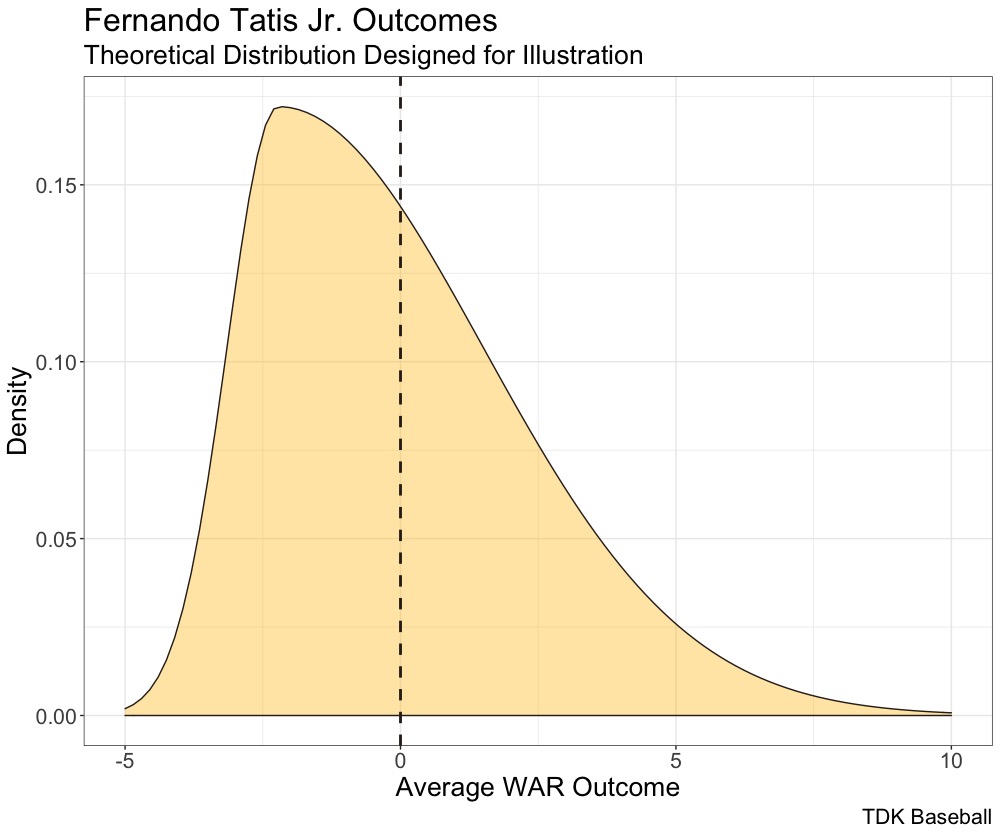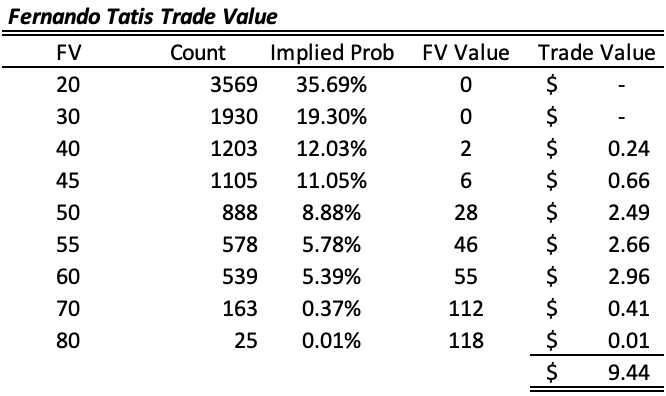Prospect Theory: We’re Here to Sell Jeans
Billy Beane provides a lot of excellent quotes in Moneyball, but perhaps none better than the following exchange with a scout:
“Over and over the old scouts will say, “The guy has a great body,” or, “This guy may be the best body in the draft.” And every time they do, Billy will say, “We’re not selling jeans here,” and deposit yet another highly touted player, beloved by the scouts, onto his shit list. One after another of the players the scouts rated highly vanish from the white board, until it’s empty.” (Lewis, 2003, 93).
“We’re not selling jeans here.” This quote is used to illustrate that body type doesn’t matter and the club is looking to acquire good baseball players, not athletes who you hope can be good baseball players down the line. There seems, however, to be a shift in this philosophy, and with teams having similar player valuations on prospects, scouting and seeing the untapped potential is the market inefficiency.
In 2016, when the San Diego Padres traded James Shields for minor leaguers Erik Johnson and Fernando Tatis Jr., Eric Longenhagen of FanGraphs wrote, “Tatis was not ranked among the 47 prospects to which former FanGraphs writer Kiley McDaniel ascribed hierarchy on his 2015 J2 Sortable Board and was not on my top 10 International Prospects list from that time. He’s blown up a bit this Spring and is one of the more interesting bats in Extended Spring Training.”
Longenhagen’s final evaluation of Tatis was, “
Given Tatis’ age and proximity to the Major Leagues, there’s obviously a substantial amount of risk here, which suppresses the Future Value grade below.
Hit: 20/50, Raw Power: 40/50, Game Power: 20/50, Run: 50/45, Field: 40/45, Throw: 60/60, FV: 40″
A 40, or a C2, that represents a bench bat or platoon player. Longenhagen wasn’t wrong in his evaluation, as Tatis was a 17-year-old who was in extended spring training. There were limited looks and given how far he was from the Major Leagues, a median outcome of a 40 with a skewed right distribution aligns with our theory. Theoretically, with a mean of 0 (FV of 40 average WAR is 0-0.7) and creating a right-skewed distribution (illustration purposes, skewness and standard deviation are made up), Tatis’ annual outcomes looked something like the following:

Using this hypothetical simulation, and using a weighted average of likely outcomes, Tatis had a trade value of about $9.5 million, or $7.5 million more than what a 40 FV is valued at in the trade market. This puts him more as a 45+ (Low C1/High C2) player instead of a 40 (C2), signaling that Tatis, perhaps, is more valuable than a traditional 40 FV (C2).

Why should the Padres, or any team really, value Tatis in 2016 at $10 million in value over the $2 million valuation of a 40? Simply because of his athleticism (note: if Tatis was closer to the bigs and wasn’t in extended spring training, perhaps he would’ve been a 45 and increasing the trade value based on our assumptions). While Tatis busts 55 percent in this hypothetical, he is also an above average big leaguer (55 or better, High B2 or better) 11 percent of the time.
Further, Eric wrote that “He has displayed improved control of his body, is making a higher quality of contact and has just generally become explosive enough that the sentiment among evaluators out here is that Tatis has a solid shot to remain a shortstop.” Tatis was improving as a player and earlier in his report, Longenhagen noted his projectability. While the current Padres star wasn’t a sure thing at the time of the trade in 2016, he had the build and athleticism, along with improvement early in extended spring, to dream upon.
Other examples show up on the defensive spectrum. FanGraphs has Jo Adell at a current 45 field and future 50, with the following description, “Adell is one of the best athletes in the minors (there’s video of him box jumping 66 inches online) and the fact that’s he’s been able to manifest these adjustments on the field at will is incredible.” Here’s Adell making a remarkable catch on Tatis.
Statcast gave the catch a 40 percent catch probability, a remarkable catch, especially one for a player projected to be average at best defensively. While Adell might not consistently make the 50 or 60 play, as one of the best athletes, he can make the 70 or 80 grade play when instincts and athleticism take over.
Another example is Cole Tucker, a shortstop by trade, who saw time in the outfield this past season for the Pittsburgh Pirates despite having no previous experience. Here he is making a diving grab in centerfield:
Tucker is another example of a great athlete who, despite playing a position he has limited time in, can make the 70 or 80 play. Watching the ball, reacting, and showing the speed is important. But it’s also important in making adjustments. While Javier Baez struggled early in his career (54 wRC+ and -0.8 fWAR in his rookie campaign in 2014), the defensive ability and quick hands allow for better adjustments.
The same can be said on the pitching side. The Pirates, back in 2018, traded off fringe 40 guys in Jordan Luplow and Max Moroff for Erik Gonzalez, Tahnaj Thomas, and Dante Mendoza. The Pirates former General Manager had the following to say about Thomas and Mendoza.
““Tahnaj Thomas is a recently converted infielder who possesses a quality frame, athleticism, a clean delivery and arm strength to create a high-ceilinged prospect. Dante Mendoza is a pitching prospect who brings many of the traits we like in young pitchers, while adding to the depth of pitching prospects with upside in our system.”
While the old saying is “There’s no such thing as a pitching prospect (TNSTAAPP)”, the top pitcher in baseball, MacKenzie Gore, has the following description per Longenhagen, “You can go wild projecting on Gore’s secondary stuff, especially the changeup, and his command because he is such an exceptional athlete, and the fact that he can repeat and maintain such an odd and explosive delivery is clear evidence of that.”
Athletes give teams more variance, but also push the ceiling higher; there’s more potential just from having quick and explosive hands, maintaining athletic stances, and not over shifting your weight. There are better opportunities to grow as a hitter by improving defense or increasing power (improves the floor by providing value on defense and on the bases) while it allows a pitcher to maintain velocity better and to better improve their kinetic chain.
The Oakland Athletics were chasing baseball players who could perform and fit within their budget constraint. While Billy Beane in Moneyball might have criticized scouts for looking at a player’s body type over performance, the game has moved along and the inefficiency for teams in trades is to acquire athletes at the lower levels. Distributions matter and skewed right outcomes can allow a team to capture more surplus in the market. Acknowledging our biases in decisions is important, and trading for athletes over players is a form of anchoring bias (we attach ourselves to those who look good doing it), but as teams are reluctant to trade prospects because of Prospect Theory, young, projectable athletes matter.
With a skewed distribution, the trading away team can obtain higher surplus if they know something about the player that will cause them to perform worse than their median outcome. Instead of trading away the 50, they’re trading away the 40. The reverse also holds true, that a team’s scouts could like the player or know how to unlock their tools. It’s an asymmetric game, but what are you willing to bet on: The 50 in Double-A with little variance in their game with limited athleticism, or the 40 in Rookie ball with an athletic build and a lot of projectability left that there are signs of improvement?
Outcome distributions matter. We’re here to sell jeans.
0 Comments on “Prospect Theory: We’re Here to Sell Jeans”